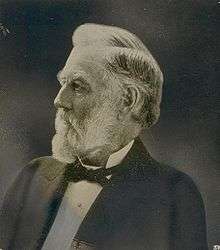Alvinza Hayward
Alvinza Hayward (1822-February 14, 1904) was a well-known gold mining millionaire who made his fortune in California. He later became a prominent financier and businessman in the San Francisco bay area.

Early life
Born in Vermont, Hayward moved to Canton, New York early in his life. He studied law in New York, but also pursued lumber and lead mining interests.
California
His experience in Michigan vein mining proved invaluable after his move to California in the Gold Rush of 1850. After buying an interest in the Eureka Mine in Amador County, Hayward made new investments and successfully extracted gold where others had failed, later selling shares in a mine which was said to have yielded more than $5,000,000.
The US Geological Survey Geographic Names Information System states the city of Hayward was named after him.[1] This is disputed by historians.[2]
Family life
Whether true or not, Hayward was often called California’s "first millionaire," and in his lifetime was frequently referred to as “the richest man in California.” Grandiose and eccentric by turns, Hayward turned even more strongly to Spiritualism in his later years, using mediums to predict business investments (with poor results). Hayward had a difficult relationship with his wife, Charity (1826-1905), whom he married in Wisconsin in the 1840s; their first son, James, was born in 1846, and would die of consumption at age 27. Divorced in 1878, the couple remarried again later that year only to separate again, living the rest of their lives apart. Only two of the couple's eight children survived to adulthood; six others died of mysterious respiratory ailments early in life, prompting recent speculation that Charity Hayward may have had a role in their demise.[3]
Hayward Park, his 800-acre (3.2 km2) estate in San Mateo, included a lake, race track, and deer park. The spectacular 1880 residence was converted into a hotel after Hayward’s death. It burned in a 1920 fire.
References
- Gudde, Erwin G., "California Place Names" (4th Ed. 1998)
- San Mateo Daily Journal Could the poor woman have been a murderer? Archived 2012-09-12 at Archive.today at www.smdailyjournal.com